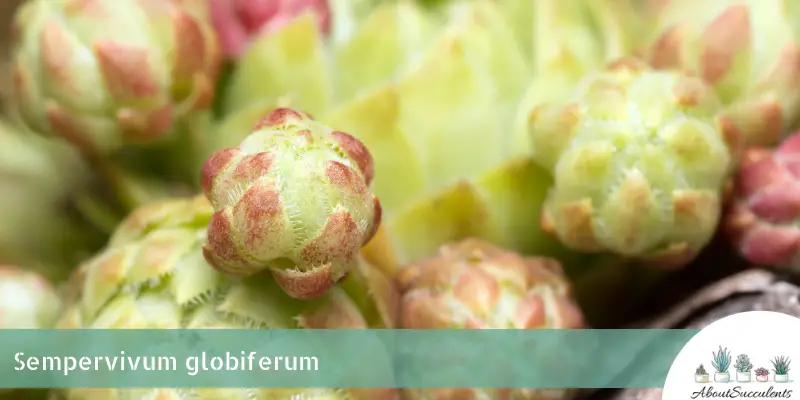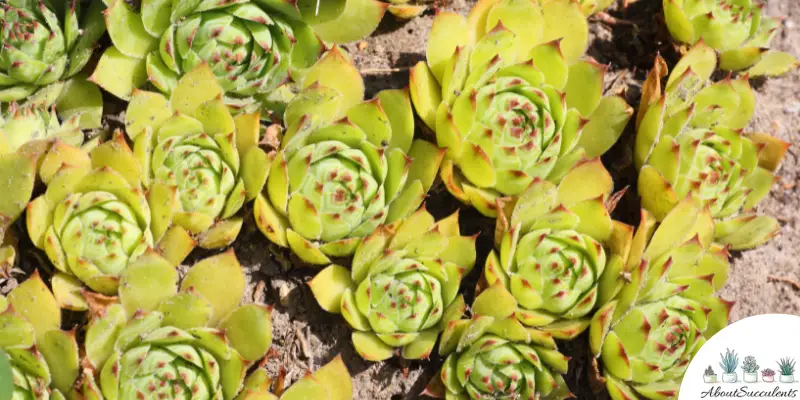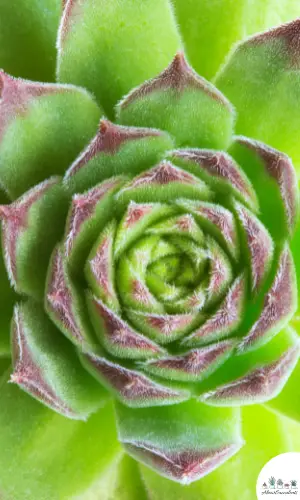
Sempervivum globiferum easily catches the attention of passers-by and house guests because its unusual appearance makes it beautiful in a bizarre way. This spiky succulent might remind you of the odd-looking Dragonfruit which looks strange on the outside but is actually soft, tasty, and sweet on the inside.
This variety of succulent comes from the genus Sempervivum and is a member of the Crassulaceae family. Sempervivum globiferum is native to the Eastern and Southern Alps, the Carpathians, and the western Balkans south to northern Albania.
Based on the regions of where the succulent can be found, you can tell that Sempervivum is a cold-hardy plant. It can tolerate temperatures as low as -20° F (-29° C).
Sempervivum globiferum’s enticing disc-shaped, lime green leaves will develop attractive red tips on their pointed ends when regularly exposed to sunlight. In some varieties of this succulent, the leaves will have a yellow-green color.
The leaves will form a tight and compact rosette that can reach a maximum height of 3-inches (7.62cm) and 3-inches (7.62cm) in width.
Sempervivum globiferum is also known as Rolling Hens and Chicks for 2 reasons. First, Sempervivum produces offsets or pups on its long stems. Succulents that produce offsets are referred to as Hens and Chicks.
Second, In time, these offsets will break off the stem and “roll” to the ground where they will take root in the soil. For this reason, Rolling Hens and Chicks is popularly used as a ground cover because they spread and grow very fast.
In the summertime, from July to August. Sempervivum globiferum produces small, bell-shaped, white flowers. As a monocarpic succulent, Rolling Hens and Chickens will die after blooming.
General Information
Also known as: Rolling Hens and Chicks, Houseleeks
Plant Family: Crassulaceae
Origin: Eastern and Southern Alps, the Carpathians, and the western Balkans south to northern Albania
Height: 3-inches (7.62cm)
Exposure: Full sun for up to 6 hours to get Hens and Chicks to attain their full colors but the succulent will also thrive with partial sun.
Water Needs: Drought-tolerant; follow the “Soak and Dry” method and water only in between dry periods.
Soil Type: Succulent soil mix or potting soil with 50% added gritty materials like coarse sand, pumice, and perlite for better drainage
Soil pH: 6.0 to 7.0
How to Grow and Care for Sempervivum Globiferum

Horticulturists who live in frosty regions – rejoice! You have the perfect succulent to grow in your garden in Sempervivum globiferum.
If you wake up one morning and find Rolling Hens and Chickens under a blanket of snow, don’t worry because they’re happy. What you need to protect your succulents from are from harsh rain.
Thus, if you experience intermittent rains, it would be a good idea to have Rolling Hens and Chickens growing in a container that you can move indoors if the weather turns wet.
Other than that, you won’t have a hard time growing and caring for Sempervivum globiferum.
Sunlight
Rolling Hens and Chickens needs 6 hours of sunlight every day in order to produce food and to attain the full spectrum of colors.
You can plant Sempervivum in outdoor rock or container gardens. Place the succulent in an area that gets partial to full sunlight every day. Avoid the afternoon rays because the leaves will burn when they come in contact with the sunlight.
As an indoor succulent, position the pot in a location where Rolling Hens and Chickens can still get up to 6 hours of partial sunlight. If this might be a problem during certain months, put Sempervivum globiferum under a Grow Light.
Watering

Unlike sunlight which Sempervivum needs 6 hours of every day, this succulent does better when it hardly receives water.
Sempervivum globiferum like other types of succulents stores water in its leaves and stems. This water-storing ability allows Rolling Hens and Chicks to survive drought conditions.
Frequent watering is not good for Sempervivum globiferum. If you water the soil too often and it remains moist for long periods of time, fungi can develop. The roots of Hens and Chicken will also rot and create an entryway for the bacteria to contaminate the entire plant.
A simple rule for properly watering succulent plants is the “Soak and Dry” method which is to water only between dry periods but to give the soil a good soaking.
The first step is to test the soil’s level of dryness. Some will just touch the topsoil and if it’s dry to the touch, they’ll give it water.
A better measure would be to insert your finger or a stick an inch deep into the topsoil and if it feels dry, prepare to give the soil a thorough drenching. Expect to water the soil more frequently during summer and less during winter.
Sometimes you’ll see scenes in a TV show where an actor sprays the succulent leaves with water. Don’t do that. Only water the soil and never the leaves. Spraying the leaves will retain moisture longer.
Pot and Soil
Overwatering is your number one enemy for growing and caring for succulent plants. Choose a pot and a type of soil that allows water to escape or evaporate faster.
Usually, a nursery will sell the succulent in a plastic container. This is just a temporary “home” for Hens and Chicks because the nursery believes the plants will be bought very soon.
Once you get Sempervivum, transfer the plant to a pot made of unglazed ceramic or terracotta because these materials allow moisture to leave the soil right away. The size of the pot must be slightly larger than the base of the plant so that the leaves won’t get tangled.
The last thing you need to do is to check the bottom of the pot. It must have a drain hole large enough to filter excess water out of the soil.
Sempervivum globiferum will thrive in a succulent soil mix or you can combine potting soil with 50% gritty materials such as coarse sand, perlite, and pumice. The addition of gritty materials will help speed up drainage.
How to Propagate Sempervivum Globiferum
As discussed earlier, Sempervium globiferum produces offsets that you can use to create more of the species.
Offsets Method
Step 1: Gently pull out the offsets that are growing near the base of the plant. You can do this by loosening the offsets by cutting the area around it with a sterilized and sharpened knife.
Step 2: Allow the offsets to dry off and grow hard calluses. It might take 2 to 4 days for the calluses to form.
Step 3: Plant the callused offsets in well-draining soil and lightly moisten it with water.
Step 4: Place the pot near a window that gets 4 to 6 hours of sunlight per day.
Step 5: If you notice the roots take hold, switch to the “Soak and Dry” method of watering.
Frequently Asked Questions
Is Sempervivum Globiferum Toxic to Cats and Dogs?
Sempervivum Globiferum doesn’t appear in the list of plants that are toxic to cats and dogs found on the website of the American Society for the Prevention of Cruelty to Animals (ASPCA).
Why Is My Sempervivum Globiferum Dying?
Sempervivum globiferum is easy to grow and care for but if you don’t watch out for signs of infection, the succulent will die. The 2 primary causes of succulent death are overwatering and pest infestation.
Overwatering
If the roots have rotted away and the fungi have found their way inside the plant, you’ll see discoloration on the leaves and feel mushy.
The first thing you have to do is to cut off these infected sections by using a sharpened and sterilized knife or garden shears. You have to remove these infected sections to keep the fungi from spreading.
Next, is to cut off the infected roots but you must disinfect the cutting tool by wiping the blade with 70% isopropyl alcohol.
Let the plant dry out. In the meantime, get a new pot and fill it up with fresh potting soil. Repot Sempervivum globiferum but don’t water the soil for up to 3 days. Give Rolling Hens and Chicks enough time to get used to the new environment.
Pest Infestation
Pests hide within the leaves of Sempervivum globiferum. These pests include mealybugs, aphids, and scale insects. They love Rolling Hens and Chicks because of the sap that can be found in the leaves.
The sap contains valuable nutrients that keep your plant healthy. You have to remove the pests otherwise, Hens and Chicks will get weaker. Also, these pests leave waxy residue on the leaves that can lead to bacterial infection.
Wipe away the substances from the leaves with a mild fungicide or a Q-Tip dipped in 70% isopropyl alcohol. Spray the succulent with diluted neem oil to keep pests away.
Yes, in the summertime, Sempervivum globiferum produces white, bell-shaped flowers. As a monocarpic succulent, Rolling Hens and Chickens will die after blooming.
Last Updated on June 9, 2022 by Sofia Lara